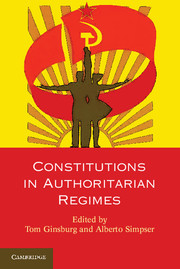Book contents
- Frontmatter
- Contents
- List of Contributors
- 1 Introduction
- Part I The Category
- Part II Constitutional Design in Authoritarian Regimes
- 4 The Political Economy of Autocratic Constitutions
- 5 Authoritarian Constitution Making
- 6 Constitutions in Authoritarian Regimes
- Part III Contents of Authoritarian Constitutions
- Part IV Consequences of Authoritarian Constitutions
- Index
- References
6 - Constitutions in Authoritarian Regimes
The Egyptian Constitution of 1971
Published online by Cambridge University Press: 05 June 2014
- Frontmatter
- Contents
- List of Contributors
- 1 Introduction
- Part I The Category
- Part II Constitutional Design in Authoritarian Regimes
- 4 The Political Economy of Autocratic Constitutions
- 5 Authoritarian Constitution Making
- 6 Constitutions in Authoritarian Regimes
- Part III Contents of Authoritarian Constitutions
- Part IV Consequences of Authoritarian Constitutions
- Index
- References
Summary
In the public protests that led to Hosni Mubarak's ouster on February 11, 2011, the abuses that Mubarak had carried out through the Egyptian constitution were part of the litany of complaints. The slogan of “bread, freedom, and social justice,” for example, encompassed demands for genuine multicandidate presidential elections, which were impossible under the constitution, and for an end to the constitutionally permissible emergency law. In a final effort to stay in power, on February 10, Mubarak announced that he had appointed a committee to amend the constitutional provisions dealing with the presidential elections and term limits, the election procedures for the People's Assembly, and the use of military courts to try civilians. He also stated that he would not run for re-election in the presidential election that was scheduled for September 2011 (although he did not say that his son Gamal would also refrain from running). For the protestors, this statement of intention to amend the most offensive articles of the constitution was seen as both insincere and insufficient to achieve genuine change in Egypt, and they refused his offer. Sustained public pressure caused senior military officials to assume control of the country.
Mubarak made his mark on the constitution in significant ways such that it was considered his constitution by the protestors, and a fundamental pressing question after his ouster was what place the document would have in the post-Mubarak era. Mubarak did not create the constitution, however; it was written in 1971, at the beginning of Sadat's presidency. As originally promulgated and then amended by Sadat in 1980, it maintained the strong executive that Sadat's predecessor Nasser had established, but it was not as authoritarian as the Nasser-era constitutional documents. Amendments adopted in 2005 and 2007 under Mubarak's watch were particularly offensive to Egyptians, especially those changes that entrenched his rule under the guise of promoting multicandidate presidential elections.
- Type
- Chapter
- Information
- Constitutions in Authoritarian Regimes , pp. 111 - 138Publisher: Cambridge University PressPrint publication year: 2013
References
- 4
- Cited by



